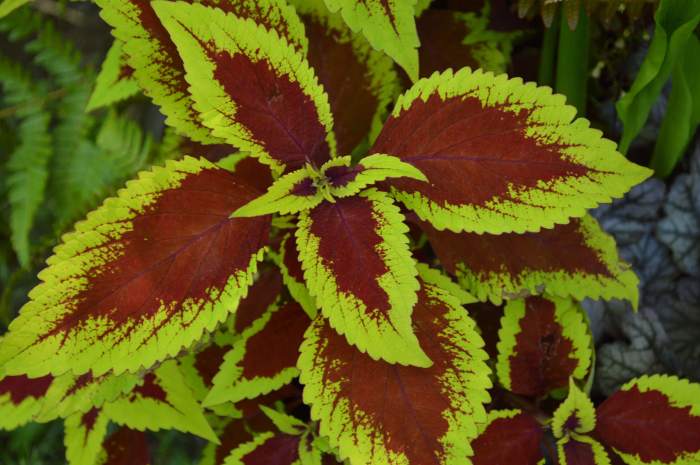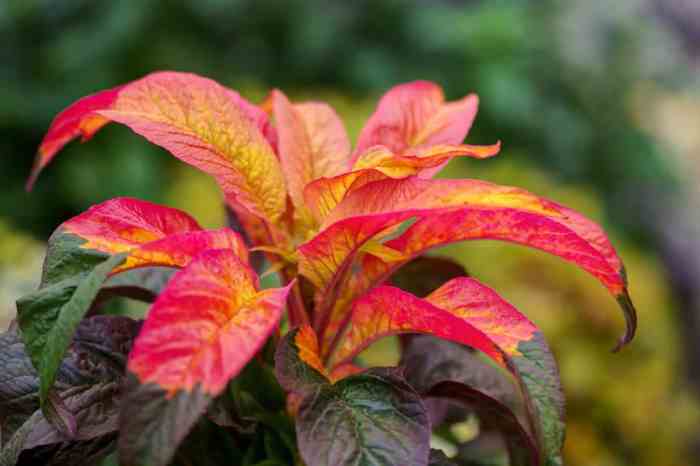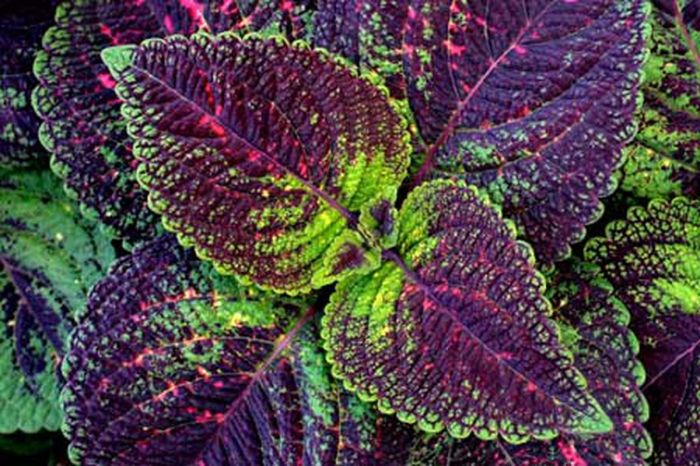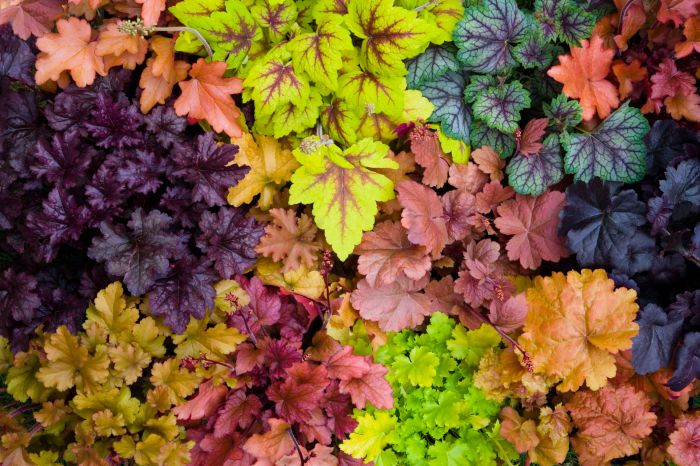Plants with colorful foliage are a gardener’s dream, adding a splash of color and visual interest to any landscape. From variegated leaves to striped and mottled patterns, the diversity of foliage colors and patterns is truly remarkable. Join us as we explore the captivating world of plants with colorful foliage, uncovering the secrets behind their vibrant hues and showcasing their stunning ornamental uses.
Prepare to be amazed as we delve into the different types of foliage, the environmental factors that influence their color, and the seasonal changes that transform their appearance. We’ll also provide practical tips on how to maintain and care for these colorful wonders, ensuring their vibrant beauty thrives in your garden.
Plant Types with Colorful Foliage

Numerous plant species showcase vibrant and captivating foliage that adds a touch of color and drama to any garden or landscape. These plants boast leaves that come in a diverse array of hues, patterns, and textures, making them a delight to behold.
The types of foliage vary widely, with some plants exhibiting variegated leaves that feature multiple colors or shades. Others display striped or mottled foliage, creating a unique and eye-catching effect.
Variegated Foliage
Variegated foliage is characterized by leaves that have two or more distinct colors or shades. These colors can be arranged in various patterns, such as stripes, spots, or blotches. Some popular variegated plants include:
- Coleus ( Solenostemon scutellarioides)
- Hosta
- Phormium (New Zealand flax)
- Caladium
Striped Foliage
Striped foliage features leaves with distinct stripes or bands of color. These stripes can be thin or wide, and they can run vertically, horizontally, or diagonally across the leaf.
- Zebra grass ( Miscanthus sinensis‘Zebrinus’)
- Variegated ginger ( Alpinia zerumbet‘Variegata’)
- Tiger lily ( Lilium lancifolium‘Tigrinum’)
Mottled Foliage
Mottled foliage is characterized by leaves that have irregular patches or blotches of color. These patches can be light or dark, and they can vary in size and shape.
- Aucuba japonica
- Aralia elata ‘Variegata’
- Begonia rex
Seasonal Changes and Foliage Color

Deciduous plants, characterized by shedding their leaves seasonally, undergo remarkable changes in foliage color throughout the year. These seasonal transformations are triggered by environmental cues, primarily the reduction in daylight hours and temperature during autumn.
Incorporating plants with colorful foliage into your backyard can instantly add vibrancy and visual interest. These plants, with their hues ranging from fiery reds and oranges to deep purples and chartreuse greens, create a captivating spectacle that transforms your outdoor space into a living canvas.
During spring and summer, chlorophyll, the green pigment responsible for photosynthesis, dominates the leaves, masking other pigments. As autumn approaches and daylight hours shorten, chlorophyll production decreases, revealing the underlying colors of other pigments, such as carotenoids and anthocyanins.
Vibrant Fall Foliage
Carotenoids, present in all plants, produce yellow, orange, and red hues. Anthocyanins, on the other hand, are responsible for the vibrant reds, purples, and blues seen in fall foliage. The intensity and variety of colors depend on factors such as the plant species, weather conditions, and soil pH.
- Sugar Maples:Renowned for their fiery red and orange hues.
- Red Maples:Exhibit vibrant shades of scarlet and crimson.
- Aspen Trees:Known for their golden yellow foliage.
- Oaks:Display a range of colors from deep red to rich brown.
- Ginkgoes:Turn a brilliant yellow before shedding their fan-shaped leaves.
Ornamental Uses of Plants with Colorful Foliage

Plants with colorful foliage offer a vibrant and eye-catching addition to any landscape or garden. Their diverse hues and textures create stunning displays that can enhance the aesthetic appeal of outdoor spaces.
Plants with colorful foliage, such as Japanese maples and hostas, can add a touch of vibrancy to any landscape. If you’re looking for a way to enjoy your colorful plants while also relaxing in a hot tub, consider building a hot tub gazebo.
These structures provide shade and shelter from the elements, making them the perfect place to unwind and soak in the beauty of your garden. For some great hot tub gazebo ideas, check out this article. Once you’ve built your gazebo, you can surround it with your favorite colorful plants to create a truly stunning oasis in your backyard.
Incorporating these plants into your garden design can add depth, contrast, and visual interest. Whether you’re creating a formal garden, a cottage garden, or a modern outdoor space, there are many ways to use plants with colorful foliage to achieve your desired look.
Mass Plantings
Mass plantings of plants with colorful foliage can create a dramatic impact in the landscape. By grouping together plants with similar or complementary colors, you can create a cohesive and eye-catching display. For example, a mass planting of red-leaved Japanese maples (Acer palmatum) can create a stunning focal point in a garden, while a grouping of variegated hostas (Hosta spp.) can add a touch of elegance and whimsy.
Specimen Plants, Plants with colorful foliage
Specimen plants are individual plants that are grown for their unique or striking appearance. Plants with colorful foliage can make excellent specimen plants, as they can add a touch of color and interest to any garden. For example, a golden-leaved Japanese cedar (Cryptomeria japonica ‘Golden Spirit’) can be used as a focal point in a rock garden, while a variegated Japanese maple (Acer palmatum ‘Bloodgood’) can be used to create a stunning specimen tree in a formal garden.
Container Plantings
Plants with colorful foliage can also be used in container plantings to add a touch of color to patios, decks, and balconies. By choosing plants with different colors and textures, you can create a vibrant and eye-catching display that will brighten up any outdoor space.
For example, a combination of variegated ivy (Hedera helix), red-leaved geraniums (Pelargonium spp.), and golden-leaved lantana (Lantana camara) can create a stunning container planting that will add a touch of color to any outdoor space.
Maintenance and Care of Plants with Colorful Foliage

Maintaining the health and vibrancy of plants with colorful foliage requires specific care practices. Understanding their unique needs is essential to preserve their aesthetic appeal and overall well-being.
To ensure optimal growth and foliage color retention, follow these tips:
Light Requirements
- Provide adequate sunlight or bright, indirect light to enhance color intensity.
- Avoid direct sunlight, which can scorch leaves and fade colors.
Water Requirements
- Water regularly, allowing the soil to dry slightly between waterings.
- Overwatering can lead to root rot, while underwatering can cause wilting and loss of color.
Fertilization
- Fertilize monthly during the growing season with a balanced fertilizer.
- Avoid over-fertilizing, as it can damage roots and hinder color development.
Pruning
- Prune regularly to remove dead or damaged leaves.
- Pinch back tips of new growth to encourage bushier plants and prevent legginess.
Temperature and Humidity
- Most plants with colorful foliage prefer warm temperatures and moderate humidity.
- Protect them from extreme cold or heat, which can damage leaves.
Repotting
- Repot as needed when roots become crowded.
- Use a well-draining potting mix specifically formulated for plants with colorful foliage.
Closure: Plants With Colorful Foliage

Plants with colorful foliage are a testament to the boundless creativity of nature, offering endless possibilities for beautifying our outdoor spaces. Whether you’re a seasoned gardener or just starting your plant-filled journey, incorporating these vibrant plants into your landscape is a surefire way to create a captivating and visually stunning oasis.